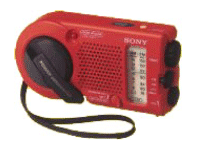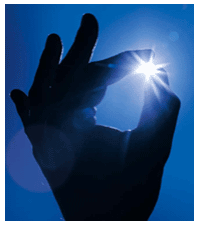Sustainable Design Awards Toolkit
Section 4.2 - Alternative energy
sources
A way in which designers can improve
a product's sustainability is to investigate the use of other
energy sources for products.
Companies leading the way in this field are the likes of Motorola
who are developing the use of Minature Fuel Cells in their products.
The Methanol Fuel Cell now in use in selected products, lasts
10 times longer than a standard rechargeable battery. Methanol
emits only water, carbon dioxide and heat giving a very efficient
hydrogen powered energy alternative to standard battery sources.
Methanol can be captured from composting various organic materials.
It eliminates the use of regular toxic batteries that contain
cadmium and lithium. Motorola are currently exploring the cells'
possibilities and it could feasibly be used in a number of other
products such as cameras and laptop computers.
Fellow leading electronics company, Sony, have also  been
investigating other energy sources for when the product is in
use. Sony have developed the 'ICF - B200' that runs off the
use of muscle power and solar energy. It works by winding up
a small dynamo that recharges the internal battery. The product
can be considered
as solar as it generates electricity by using a renewable energy
source during use. been
investigating other energy sources for when the product is in
use. Sony have developed the 'ICF - B200' that runs off the
use of muscle power and solar energy. It works by winding up
a small dynamo that recharges the internal battery. The product
can be considered
as solar as it generates electricity by using a renewable energy
source during use.
Many companies like Sony are looking into these alternative
methods to achieve energy. Wind-up shavers are even being looked
at! The idea is that by achieving a pump action on a rotary
shaver the product may be used anywhere as it needs no electricity
or batteries. In fact you have control of the head speed, as
it's dependent on how fast you pump!
Freeplay (www.freeplay.net) are
developing the
use of human powered portable products with an aim to reduce
the consumption of power. Most of their products use human power
as a mechanical energy source in a wind-up mechanism to run
the portable device. An internal spring is engaged by the rotation
of an external handle. The user therefore turns handle, and
the energy is stored in the spring. Freeplay use a strip steel
spring that offers excellent ergonomic power as well as a constant
force for the product. The system converts energy to electricity,
any extra could be stored in a rechargeable battery. Techniques
like those used at Freeplay could be used on a number of other
devices such as transceivers, cell phones, navigating aids and
military equipment.
|
Freeplay have recently teamed up with various mobile phone companies
to try and incorporate more sustainable products into the mobile
phone world. In 2002
Freeplay and Motorola are releasing 'Freecharge', a lightweight, robust wind-up
phone charger. It's billed not only as a sustainable product but one which puts
an end to so-called dead mobiles as it works where ever you are. It uses a rugged
generator wind-up system, wound up by a crank handle. For 45 seconds of winding
the phone allows around 6 minutes of talktime and hours of standby time!
|
Further information on Freeplay and their products can be found on their website at:
www.freeplay.net
For information on 'Freecharge' visit: www.motorola.com
|
|
Philips�(www.solar.philips.com)
recognise that sustainability for them is achieving a balance
between ecological impact and economic growth. They and other
companies are seeing it more and more as an opportunity to challenge
present thinking, allowing greater creativity for eco-efficient
solutions. They have started to achieve this by introducing
a series of products that underline that statement. They are
currently producing more sustainable items such as: Free-powered
radios, Gyroscan Intera Medical scanners, Energy-saving e-Kyoto
electronic ballasts and also flexible and mouldable solar panels.
These solar panels have a large scope for products having low
maintenance, no noise and a long life. Philips boast that it
is guaranteed for 10 years with a minimum power of 90%. Additional
work in the solar category is currently being undertaken by
Phillips and similar leading companies. |
Alternative Energy sources do not just have to be from products
in use. A food factory in Denmark 'Urtekran', use an alternative
energy source during manufacture and distribution. The factory
is powered by wind and hay, and can be considered more solar
by usingrenewable energy sources in the manufacturing process.
|
|
|
 
 |
Inspirational Current Work
|
 |
�
|
 |
Toolkit Index


|
|

